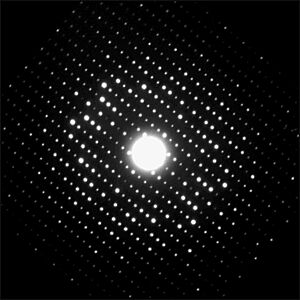Crystallography facts for kids
Crystallography is the study of how atoms are arranged in solid materials. Think of it like figuring out the tiny building blocks and how they fit together in a perfect, repeating pattern.
Before powerful tools like X-ray crystallography were invented, scientists studied crystals by looking at their shapes. They would measure the angles of the crystal faces and try to understand their symmetry (how they look the same when turned or flipped).
Contents
How X-rays Help Us See Atoms
Today, we find out crystal structures by shining a special beam of energy at a sample. We then look at the diffraction patterns that are created. These patterns are like unique fingerprints that tell us how the atoms are arranged.
This amazing technique was invented by Sir William Henry Bragg and his son Sir Lawrence Bragg. They won the Nobel Prize in Physics in 1915 for their work. Lawrence Bragg was the youngest person ever to win a Nobel Prize at that time! He was also in charge of the Cavendish Laboratory at Cambridge University when James D. Watson and Francis Crick discovered the structure of DNA in 1953.
Most often, scientists use X-rays for this study. But sometimes, they use beams of electrons or neutrons instead. Each type of beam interacts with atoms differently. This means they are useful for different kinds of crystallography studies.
How the Technique Works
Some materials, like proteins, don't naturally form crystals. To study them, scientists put these molecules into a liquid solution. Then, they wait for days, weeks, or even months for tiny crystals to grow.
Once a crystal is ready, data can be collected using a beam of radiation. While regular X-ray machines are common, crystallography often uses special synchrotron light sources. These are like giant X-ray factories! They produce much purer and stronger X-ray beams. This means collecting data takes only a fraction of the time compared to weaker sources.
Turning a diffraction pattern into a clear image of the atoms needs some very complex mathematics.
The math used for diffraction data only works when waves hit an orderly arrangement of atoms. This is why crystallography mostly applies to crystals. It also works for molecules that can be made to crystallize.
Even so, we can still learn a lot about molecules from patterns made by fibres and powders. For example, the famous double-helix shape of DNA was figured out from an X-ray diffraction pattern taken from a fibrous sample.
Electron Diffraction
Electron crystallography is another way to find out how atoms are arranged in solids. It uses a special tool called a transmission electron microscope (TEM). This method was developed by Aaron Klug. He won the Nobel Prize in Chemistry in 1982 for his studies on virus structures and transfer RNA.
The first time electron crystallography was used to see a protein structure in atomic detail was in 1990. This protein was called bacteriorhodopsin.
Real-World Examples
Crystallography in Engineering
Crystallography is a very important tool in materials science. This field studies how materials are made and how they behave. Understanding crystal structures helps engineers understand tiny flaws or "defects" in materials.
Many other physical properties of materials are linked to their crystal structure. For example, the minerals in clay form small, flat, plate-like shapes. Clay can be easily shaped because these flat particles can slide past each other. But they stay strongly connected in the direction perpendicular (at a right angle) to the plates. Crystallography helps us study these kinds of movements and properties.
Crystallography also helps us understand the symmetry patterns that atoms can form inside a crystal.
Biology
X-ray crystallography was the main way to figure out the 3-D shapes of large biological molecules. These include important molecules like enzymes and nucleic acids, such as DNA and RNA. In fact, the famous double helix structure of DNA was discovered using data from X-ray crystallography.
The first crystal structure of a large biological molecule was solved in 1958. Today, there's a huge online library called the Protein Data Bank (PDB). It holds the structures of many proteins and other biological molecules. Special computer programs can help scientists look at and understand these complex structures.
For large molecules that don't form big 3-D crystals, electron crystallography is now often used instead of X-ray crystallography.
Images for kids
-
A crystalline solid: atomic resolution image of strontium titanate. Brighter atoms are strontium and darker ones are titanium.
See also
 In Spanish: Cristalografía para niños
In Spanish: Cristalografía para niños




